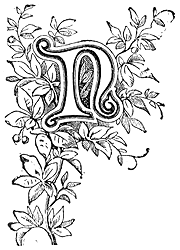 |

ORWICH is built on an eminence, and covers a large space of ground, with openings planted with trees, and many towers of churches. Fuller describes it as "either a city in an orchard, or an orchard in a city." At its foot runs the river Wensum, Norwich rose on the decay of Caister or Caster St. Edmund's, now a small village three miles from the town. An old rhyme records that-
Thetford was the metropolis of East Anglia, but Norwich was one of its best towns, and its kings erected a royal fortress there on a promontory on the shore of the estuary of the sea, which is now in the centre of the town, and called the Castle Hill. The town grew, as towns always did beneath the protecting shadow of a fortress, and by the time of Edward the Confessor, Norwich exceeded in wealth and population every town in England, except London and York.
The castle (standing as we have said on a lofty eminence, now in the middle of the city) is of Norman construction, and was undoubtedly built on the site of the strong fortress erected by Uffa, the first King of East Anglia, about 575; the fact that lands were granted to the monastery of Ely, in 677, charged with castle guard to Norwich Castle supports this theory.
In the Conqueror's reign Norwich Castle was entrusted to Ralf de Guader, Earl of Norfolk, but he rebelled, according to the wont of William's barons, was defeated, and fled from Norwich, where he took shipping to Bretagne. His wife bravely defended the castle, but was at last obliged to capitulate.
The constableship of the castle was then given to Roger de Bigod, or Bigot, who is believed to have built the keep. He held the castle after the Conqueror's death for Robert of Normandy, William Rufus's elder brother, but at the peace of 1091 Roger accepted a pardon from the Red King, and retained the castle. He is supposed to have proposed and aided in the removal of the bishopric of the Fast Angles from Thetford to Norwich, and to have founded the cathedral. Henry I. granted the city a charter, and soon after the Flemings appeared in the town, and established the woollen manufacture. Except for a short interval, Norwich Castle remained under the rule of the Bigods till the reign of Henry III.; though John seized the castle during the Barons' Insurrection. After John's death the city was taken by the Dauphin Louis, but when he had retired from the kingdom, it was restored to the Bigods. In 1224 , one of the family surrendered the castle to the king. It was made the common prison, but is now used as a museum. The keep is 110 feet 3 inches from east to west, and 92 feet 10 inches from north to south; the height to the battlements is 69 feet 10 inches. On its east side there is a projecting tower called Bigod's Tower, and upon the upper ballium are the remains of two circular towers fourteen feet in diameter. The keep has been refaced, and Bigod's Tower restored.
Caistor Castle is one of the four chief castles of Norfolk. It is situated near Yarmouth. It is built of brick, and is thought to be one of the oldest brick buildings in the kingdom.
But it has been given a much later date, some antiquarians ascribing its erection to Sir John Fastolfe, an officer who served in the wars of Henry V. and Henry VI. It became at last the possession of Sir John Paston, and was twice besieged in the Wars of the Roses. This gentleman - Sir John Paston - was one of the writers of the celebrated Paston letters, from which we derive so much knowledge of the dark period to which they relate. An embattled tower at the north-west comer, one hundred feet high, and the north and west walls alone remain.
Caistor was once a place of great importance, and the abode of the kings of East Anglia. Edmund, the Saxon King, also kept his court here.
|
 |